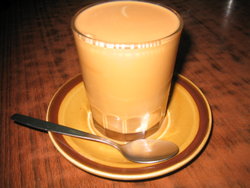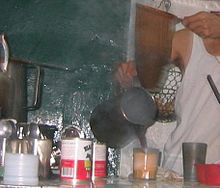- Hong Kong-style milk tea
-
Hong Kong-style milk tea 
Hot milk tea in a glass Chinese 港式奶茶 Literal meaning Hong Kong-style milk tea Transcriptions Mandarin - Hanyu Pinyin Gǎngshì nǎichá Cantonese (Yue) - Jyutping gong2 sik1 naai3 caa4 Alternative Chinese name Chinese 香港奶茶 Literal meaning Hong Kong milk tea Transcriptions Mandarin - Hanyu Pinyin Xiānggǎng nǎichá Second alternative Chinese name Traditional Chinese 大排檔奶茶 Simplified Chinese 大排档奶茶 Literal meaning dai pai dong milk tea Transcriptions Mandarin - Hanyu Pinyin dàpáidàng nǎichá Cantonese (Yue) - Jyutping daai6 paai4 dong3 naai3 caa4 Hong Kong-style milk tea is a beverage originating from Hong Kong consisting of black tea with evaporated milk or condensed milk. It is usually part of lunch in Hong Kong tea culture. Although originating from Hong Kong, it is also frequently found overseas in restaurants serving Hong Kong cuisine and Hong Kong-style western cuisine.
Contents
Origin
Hong Kong-style milk tea originates from British colonial rule over Hong Kong. The British practice of afternoon tea, where black tea is served with milk and sugar, grew popular in Hong Kong. Milk tea is similar, except with evaporated or condensed milk instead of ordinary milk. It is called "milk tea" (Chinese: 奶茶, Cantonese naai5 cha4) to distinguish it from "Chinese tea" (Chinese: 茶, Cantonese cha4), which is served plain.
Production
"Silk stocking" milk tea Making milk tea with a "silk stocking" Traditional Chinese 絲襪奶茶 Simplified Chinese 丝袜奶茶 Literal meaning silk-stocking milk tea Transcriptions Mandarin - Hanyu Pinyin sīwà nǎichá Cantonese (Yue) - Jyutping si1 mat6 naai5 caa4 - IPA [ɕíː mɐ̀t na̬ːi tsʰa̭ː] Hong Kong-style milk tea is made of a mix of several types of black tea (the proportion of which is usually a "commercial secret" for some milk tea vendors, often Pu Lei and a type of Ceylon tea), evaporated milk, and sugar, the last of which is added by the customers themselves unless in the case of take-away. A variety uses condensed milk instead of milk and sugar, gives the tea a richer feel.
To make the tea, water and tea (about 1 to 3 teaspoons of tea a cup, depending how strong the drinker likes) are brought to a boil then simmered for about 3–6 minutes. The tea is usually put in a sackcloth bag before the water is added to the pot to filter it out or if no bag available poured through a strainer. Many people also remove the pot from the heat once it boils for about 3 minutes, then bring the pot to a boil again. This process can be repeated several times, intensifying the caffeine/flavor.[citation needed]
The key feature of Hong Kong-style milk tea is that a sackcloth bag is used to filter the tea leaves. However any other filter/strainer may be used to filter the tea. Sackcloth bags are not completely necessary but generally preferred. The bag, reputed to make the tea smoother, gradually develops an intense brown colour as a result of prolonged tea drenching. Together with the shape of the filter, it resembles a silk stocking, giving Hong Kong-style milk tea the nickname of "pantyhose" or "silk stocking" milk tea (Chinese: 絲襪奶茶). This nickname is used in Hong Kong but less so in mainland China and overseas communities.[1]
There are debates over the authentic way of making milk tea, i.e. the sequence of adding each ingredient. Some people argue that milk should be added before pouring the tea, while some hold the opposite view. Most people do agree that both ways are authentic. In the past, however, milk tea were usually made in the tea-after-milk way. It is said that the cups may break when the tea (which can be as hot as 80–90 degree Celsius) is poured. There is also a saying that the milk is sterilized when the tea is added.[citation needed]
Milk tea is a popular part of many Hong Kongers' daily lives, typically served as part of afternoon tea, but also at breakfast or dinner. It enjoys nearly the same ubiquitous status that coffee holds in the West. Whilst not offered by more traditional Cantonese restaurants or dim sum teahouses, milk tea is standard fare in Hong Kong-style western restaurants and cha chaan teng, as well as Hong Kong's historic dai pai dong, with a price between HKD$8–$12 (hot, one or two dollars more for cold). A cup of hot milk tea is usually either served in a ceramic cup (often referred to as a "coffee cup" 咖啡杯) or a tall cylindrical plastic glass.
In contrast, some expatriate Westerners and tourists may not hold milk tea in as high regard. The 2006 edition of the Rough Guide to Hong Kong and Macau compares the local milk tea unfavourably with "proper" English tea served in more formal Western cafes and hotels such as the Peninsula Hotel, citing different cultural preferences. In the Lonely Planet World Food Hong Kong, traditional Chinese tea and high teas in hotels are favoured over milk tea, which is not mentioned at all.
Criteria for quality milk tea
The first criterion of a good cup of milk tea is its "smoothness" (香滑); in other words, how creamy and full-bodied it is.
Another criterion for tasty milk tea (and also bubble tea) is some white frothy residue inside the lip of the cup after some of it has been drunk. This white froth means that the concentration of butterfat in the evaporated milk used is high enough.
The taste and texture of 'Hong Kong' style milk tea might be influenced by the milk used. For example, some Hong Kong cafés prefer using a filled milk variant, meaning it is not purely evaporated milk (as with most retail brands) but a combination of skimmed milk and soybean oil.
Varieties
Today, iced milk tea is usually prepared with ice cubes. However, in the old days, when machines for producing ice cubes were not popular, the iced milk tea was made by filling the hot milk tea into a glass bottle and then cooling it in a fridge. Sometimes the milk tea were filled in Vitasoy or Coca-Cola bottles, and were sold by bottle. Today this type of "bottle milk tea" is rare in Hong Kong. Iced milk tea in cans or plastic bottles can be found in many of the convenience stores around Hong Kong such as 7-Eleven and Circle K.
In the case of milk tea with ice cubes, the melting ice will dilute the content, thus affecting the taste of the drink; therefore, many people prefer the old way of preparing iced milk tea. Today, some cha chaan tengs serve ice-less iced milk tea, made by pouring hot milk tea into a plastic cup and then cooling it in a fridge. Another way is to place the cup/bottle into a cold water bath, which is called 冰鎮奶茶. This is often used as a selling point.
Cha chow Traditional Chinese 茶走 Simplified Chinese 茶走 Literal meaning "tea without [evaporated milk]" Transcriptions Mandarin - Hanyu Pinyin chá zǒu Cantonese (Yue) - Jyutping caa4 zau2 - IPA [tsʰa̭ː tsɐ̌u] Cha chow (Chinese: 茶走) is milk tea prepared with condensed milk, instead of evaporated milk and sugar. Its taste is, as can be expected, sweeter than ordinary milk tea. In the old days,[clarification needed] Cha chow was mostly drunk by older people who had "congestion" in their throats.
Milk tea and coffee together is called yuan yang (yin yang) (鴛鴦).
A variation on "silk stocking tea" is "silk stocking coffee".
See also
- Cuisine of Hong Kong
- Hong Kong-style Western cuisine
References
- ^ CNN Go 40 Hong Kong foods we can't live without 13 July 2011. Retrieved 2011-10-09
External links
- Recipe of HK Style Milk Tea, and Yuanyang
- Recipe of Hong Kong Style Milk Tea, Teas.com.au
- Hong Kong Milk Tea in Central
- Step by Step Guide on How to make Hong Kong Style Milk Tea
- (Chinese) How to make "silk stocking" milk tea, Apple Daily
- (Chinese) The origin of "silk stocking" milk tea, Apple Daily
- Association of Coffee & Tea Hong Kong
Tea Black tea Oolong tea - Bai Ji Guan
- Red Robe
- Darjeeling Oolong
- Dongding (Tung-ting)
- Dong Fang Mei Ren
- Huangjin Gui (Golden Osmanthus)
- Qilan tea
- Pouchong
- Rou Gui
- Shui Jin Gui
- Shui Hsien (Shui Xian)
- Tie Luohan
- Tieguanyin (Iron Goddess)
Green tea - Aracha
- Bancha
- Green Spiral
- Chun Mee
- Da Fang
- Genmaicha
- Liuan Leaf
- Gunpowder
- Gyokuro
- Hojicha
- Hou Kui
- Huang Shan Mao Feng
- Hyson
- Kabusecha
- Kamairicha
- Konacha
- Kukicha
- Longjing (Dragon Well)
- Matcha
- Mao Jian
- Mecha
- Meng Ding Gan Lu
- Sencha
- Shincha
- Tamaryokucha
White tea Yellow tea Post-fermented tea Blended and
flavoured teasTea culture Tea beverages - Bubble tea
- Butter tea
- Hong Kong-style milk tea
- Iced tea
- Lei cha
- Jagertee
- Sweet tea
- Suutei tsai
- Teh tarik
- Teh botol
- Noon Chai
Other - Camellia sinensis (tea plant)
- Tea bag
- Teapot
- Consumption
- Flowering tea
- Glass-holder
- Health effects
- Tea processing
- Samovar
- Tea brick
- Tea garden
- Tea house
- Tea tasting
- Teakettle
See also Categories:- Tea
- Hong Kong cuisine
- Hong Kong beverages
- Tea culture
- Cantonese cuisine
- Dim sum
Wikimedia Foundation. 2010.


